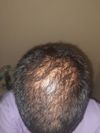community 4 months of topical min, fin, keto, dermastamp, rosemary and peppermint oil
The conversation discusses a person's 4-month hair loss treatment regimen using topical minoxidil, finasteride, ketoconazole, a dermastamp, and rosemary and peppermint oils. Progress pictures are shared to show the results.

